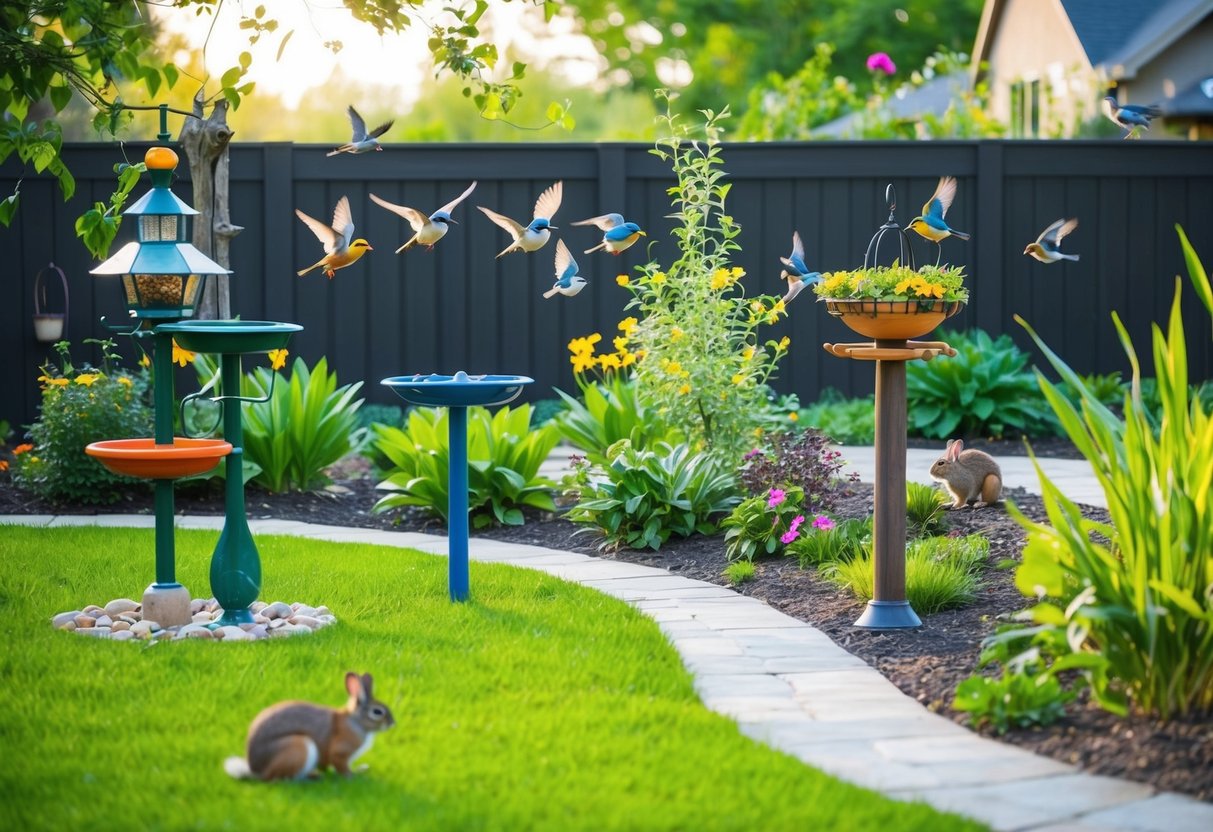
Providing Food Sources for Birds
Offering an inviting environment for birds involves creating diverse food options. Essential considerations include setting up appropriate feeders and ensuring a variety of natural and supplemental diets.
Setting Up Bird Feeders and Birdseed Selection
Bird feeders come in numerous styles suited for different bird species. Tube feeders, hopper feeders, and platform feeders all cater to various dietary habits. Choosing the right feeder depends on the birds native to the region. For instance, tube feeders often attract smaller birds, while hopper feeders are ideal for larger songbirds.
When it comes to birdseed, selecting a mix that incorporates black oil sunflower seeds is recommended. These seeds are nutrient-rich and liked by many bird species. Suet is also a valuable addition, particularly in colder months, as it provides essential energy. Feeding stations should be regularly cleaned to avoid disease transmission and placed in locations offering safety from predators.
Natural Food Sources: The Importance of a Varied Diet
Encouraging birds to forage naturally enhances their health and diversity in the backyard ecosystem. Planting native shrubs and trees can provide fruits, seeds, and nuts that supplement the diet. Berry-producing plants, such as elderberry or holly, are excellent in attracting a variety of birds.
Insect-rich environments are crucial as they offer protein, especially for nesting and migratory birds. Maintaining a garden that encourages native bug populations can benefit this process. Avoid using pesticides, as they reduce food availability and can harm birds directly. Allowing some fallen leaves and branches increases insect habitats, supporting a well-rounded diet and fostering a vibrant bird-friendly environment.
Watering Spots and Shelter
Providing water and shelter in your backyard is essential for attracting and supporting local bird populations. Incorporating bird baths and birdhouses can create a thriving habitat for various species.
Bird Baths and Their Role in Attracting Birds
Bird baths are effective water features for enticing birds. They provide a clean and fresh water source essential for drinking and bathing. Birds use the bath to remove dust and dirt from their feathers, helping them maintain good health. When choosing a bird bath, shallow designs are ideal as they mimic natural puddles and make the birds feel safer.
Positioning is critical for bird baths. Placing it near shrubs or trees offers birds a quick escape route if threatened. Regular cleaning prevents algae buildup and helps avoid diseases. Adding stones or pebbles can provide safe perches, encouraging more birds to visit frequently.
Providing Safe Nesting Sites with Birdhouses
Birdhouses offer vital nesting sites, especially in urban areas where natural cavities are scarce. When selecting or building birdhouses, materials like untreated wood are recommended for durability and bird safety. Appropriate entry hole size is essential to accommodate the target bird species while deterring larger predators.
Positioning birdhouses affects their success rate. Ideally, they should be placed at a height of 5 to 10 feet, away from prevailing winds and predators. Attaching predator guards can enhance safety and nesting success. Maintenance includes annual cleaning after the breeding season to remove any debris or pests. This upkeep encourages reuse by the same or new birds each year.
Safe Havens: Protecting Wildlife from Predators
Creating a bird-friendly backyard requires implementing strategies to protect wildlife from common predators. Ensuring safe havens involves addressing threats posed by outdoor cats and designing the landscape in a way that shelters wildlife.
Managing Outdoor Cats and Other Predators
Outdoor cats pose a significant threat to birds and other small wildlife. Owners are encouraged to keep their cats indoors or provide them with supervised outdoor time in enclosed spaces, often referred to as “catios.” These structures offer a safe environment for cats without endangering wildlife. Additionally, installing motion-activated sprinklers or ultrasonic devices can deter both cats and other potential predators from entering the backyard.
Collars with bells or brightly colored patterns can also help by alerting birds to a cat’s presence. Focusing on responsible pet ownership and predator control is crucial in maintaining a safe environment for wildlife.
Structuring Safe Zones with Landscaping
Proper landscaping techniques can provide birds and small animals with sanctuary areas. Planting dense shrubs and using thorny bushes can create natural barriers, deterring predators and offering birds places to hide. Taller trees and layered vegetation add vertical space, increasing safety for perching and nesting.
Incorporating elements like brush piles or rock formations can serve dual purposes: they offer habitats for various creatures and keep predators at bay. Choosing native plants can bolster these efforts, as they naturally align with local wildlife needs and offer better protection.
Through thoughtful planning and design, creating a protective landscape encourages a thriving wildlife-friendly backyard.